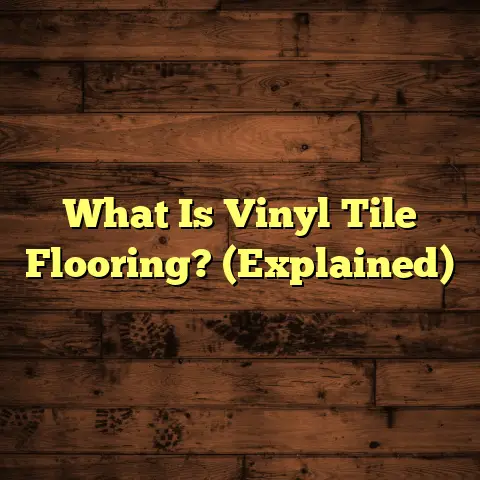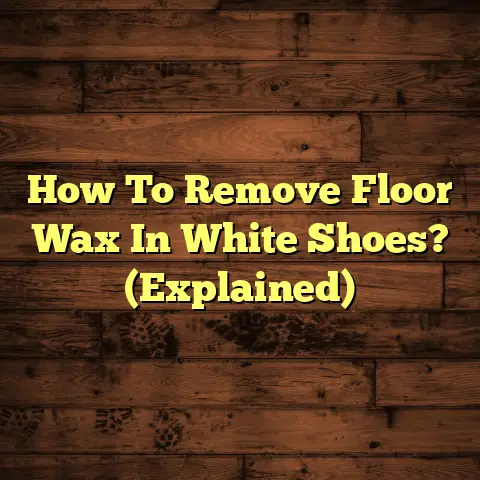Why Paint Basement Floor? (4 Hidden Risks!)
I’ve spent years helping homeowners just like you transform their spaces, and I want to talk about something super important: your basement floor.
Think about your basement. Is it the kids’ playroom?
The ultimate family movie night zone?
Maybe even your personal home gym?
We pour our hearts (and wallets!) into making these spaces safe, functional, and fun for the whole family.
But what about the floor? Is it just bare concrete?
If so, you might be overlooking some serious hidden risks that could impact your family’s health and safety.
Trust me, I’ve seen it all.
Let’s dive into why painting your basement floor isn’t just about making it look pretty – it’s about protecting your loved ones.
1. The Importance of a Well-Maintained Basement Floor
Your basement is more than just an underground space.
It’s the foundation of many family activities, a place where memories are made.
Think about the materials down there.
Concrete is the most common, but are you aware of its implications for safety and comfort?
While aesthetics are important, the functionality and safety of your basement floor are paramount for your family’s wellbeing.
I always tell my clients, “It’s not just a floor; it’s the stage for your life!”
2. Hidden Risk #1 – Moisture and Mold Growth
Okay, let’s get real about moisture. Basements are notorious for it.
Why? Think about it:
- Groundwater: It seeps in through the foundation.
- Humidity: Condensation forms on cool surfaces.
- Leaks: Plumbing issues can cause sneaky water damage.
Unpainted or poorly maintained basement floors? They’re basically an open invitation for mold and mildew.
I’ve seen basements with mold so bad, it looked like something out of a horror movie!
And this isn’t just a visual problem. It’s a serious health hazard, especially for kids, the elderly, or anyone with respiratory issues.
What are the symptoms of mold exposure? Think:
- Allergies: Sneezing, runny nose, itchy eyes
- Asthma: Worsening symptoms, wheezing, coughing
- Respiratory Infections: Bronchitis, pneumonia
Long-term exposure can lead to even more serious problems.
Trust me, you don’t want to mess around with mold.
I once had a client whose child developed chronic asthma because of hidden mold in their basement.
It was a tough situation, and it could have been prevented with a little foresight.
3. Hidden Risk #2 – Chemical Exposure
Now, this one might surprise you, but basements can be a hotspot for chemical exposure.
Unsealed concrete is porous, meaning it can absorb chemicals from the soil around your home.
Think radon, pesticides, or even industrial chemicals from previous land use.
Certain paints act as a barrier, preventing these harmful substances from seeping into your living space.
When choosing a paint, pay close attention to the Volatile Organic Compounds (VOCs) content.
VOCs are chemicals that evaporate from paint and can cause health problems.
I always recommend going with non-toxic, low-VOC options.
Your family will thank you.
I always tell my clients that there are paints available with zero VOCs.
I know, it might seem like overkill, but when it comes to your family’s health, is there really such a thing?
4. Hidden Risk #3 – Structural Integrity
This is where things get serious.
Neglecting your basement floor can actually affect the structural integrity of your entire home.
Water damage is the main culprit.
It can lead to:
- Cracking: In the foundation and floor
- Settling: Uneven floors and walls
- Shifting: Major structural problems
Painting the basement floor helps seal and protect it from moisture, prolonging the life of your home.
Think of it as an investment in your property’s future.
I’ve seen homes where water damage in the basement led to thousands of dollars in foundation repairs.
A simple coat of paint could have prevented the whole thing.
Here’s a thing to consider, according to the American Society of Civil Engineers (ASCE), approximately 25% of homes experience some form of foundation problem during their lifetime.
These issues often start in the basement, so taking preventative measures is crucial.
5. Hidden Risk #4 – Slips and Falls
Let’s talk about safety.
An unpainted basement floor can be surprisingly slippery, especially when it’s damp.
I’ve seen kids running around in basements, only to slip and fall on the bare concrete.
It’s a recipe for disaster, especially if you have young children or elderly family members.
According to the National Safety Council (NSC), falls are a leading cause of injury in the home.
A properly painted floor can significantly reduce the risk of slips and falls.
Look for paints with anti-slip additives or textured finishes.
These provide extra grip, making your basement a safer place for everyone.
I recommend adding a clear, anti-slip additive to your paint.
It doesn’t change the color or finish, but it adds a ton of extra traction.
Trust me, it’s worth the investment.
Conclusion: Emphasizing Family Safety and Comfort
So, why paint your basement floor? It’s not just about aesthetics.
It’s about safeguarding the health and wellbeing of your family.
Let’s recap those hidden risks:
- Moisture and Mold: Protect your family from respiratory problems.
- Chemical Exposure: Create a barrier against harmful toxins.
- Structural Integrity: Prevent costly foundation repairs.
- Slips and Falls: Reduce the risk of accidents.
Investing in a painted basement floor is an investment in your family’s future.
A safe, functional, and well-maintained basement can greatly enhance your family life, making it a space where cherished memories are made.
Don’t wait until it’s too late.
Take action today and protect your loved ones.
If you are considering to calculate the cost for painting your basement floor, here is a table:
| Item | Description | Average Cost (USD) |
|---|---|---|
| Materials | ||
| Paint (Epoxy or Acrylic) | High-quality, moisture-resistant paint suitable for concrete floors | \$30 – \$50 per gallon |
| Primer | Concrete primer to ensure proper adhesion and sealing | \$20 – \$40 per gallon |
| Sealer (Optional) | Clear concrete sealer for added protection and durability | \$25 – \$45 per gallon |
| Cleaning Supplies | Concrete cleaner, degreaser, scrub brush, mop, buckets | \$20 – \$50 |
| Tools | Paint rollers, brushes, trays, extension poles, painter’s tape | \$30 – \$60 |
| Safety Gear | Gloves, safety glasses, respirator or mask | \$15 – \$30 |
| Labor | ||
| Professional Painting | Cost per square foot for professional surface preparation, priming, and painting | \$2 – \$4 per sq ft |
| Equipment Rental | ||
| Concrete Grinder | Rental for preparing the surface by removing old coatings or imperfections | \$50 – \$100 per day |
| Dehumidifier | Rental to reduce moisture levels in the basement before painting | \$30 – \$50 per day |
| Miscellaneous Costs | ||
| Repairs | Costs for patching cracks, filling holes, or addressing minor structural issues | Varies |
| Disposal Fees | Charges for disposing of old paint, cleaning supplies, and other waste materials | \$10 – \$30 |
| Total Estimated Costs | ||
| DIY Project | Costs for materials, tools, and safety gear if you choose to paint the floor yourself | \$150 – \$500+ |
| Professional Project | Costs for materials, labor, and equipment rental for professional painting services | \$500 – \$2,000+ |
Disclaimer: These costs are estimates and can vary based on location, the condition of the floor, and specific product choices.
Alright, that’s all from me for today.
Stay safe, and happy flooring!





